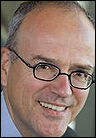One hundred consumers who shop at the C1000 grocery store in Molenaarsgraaf, the Netherlands, have begun paying for transactions with mobile phones equipped with Near Field Communications (NFC) RFID chips. The group is participating in a six-month pilot conducted by Schuitema, the nation’s second largest retail chain, which—in an effort to improve efficiency at the checkout counter—is testing RFID in one of its 450 C1000 stores.
The pilot began in mid-August and will run through February 2008. This, says Rover van Mierlo, Schuitema’s director of central logistics and research and development, is the first step toward gauging how the use of NFC technology in mobile phones can speed transactions at the point of sale. Van Mierlo says Schuitema intends to share the results of the pilot with Dutch banks and merchants, including C1000’s competitors.
In the Molenaarsgraaf store, RFID interrogators have been added to checkout terminals, a machine that accepts empty returnable bottles and kiosks used by consumers to make charitable donations. For the pilot, the store provided 100 of its customers with free NFC-enabled telephones from Samsung.
Participants can use the phones to pay for purchases and carry out other financial transactions at the store. The phones have an embedded 13.56 MHz NFC RFID module and were provided by telephone services company KPN and Rabobank Group, which also supplied financial services and an interface between the store and Rabobank’s accounts.
A participant inserts bottles, one at a time, through a receptacle in the bottle-return machine, which counts them and totals up the deposits to be refunded. The consumer then places the NFC-enabled phone next to the machine’s, interrogator, which captures the unique ID number on the phone’s NFC module. Using LogicaCMG software, the phone displays the total deposit refund the customer has earned.
After completing the bottle-return transaction, pilot participants can present their phones to an RFID-enabled kiosk that accepts donations directly from the bottle-return balance. If they choose to donate, proceeds go to a charity for Ukrainian children. The kiosk’s interrogator captures the phone’s unique RFID ID number and lets a user specify a donation amount, which it withdraws directly from the balance. The kiosk can also deposit the balance directly into the participant’s Rabobank account, rather than donating it to charity. A third alternative is for a customer to finish shopping and use the balance to defray the cost of groceries.At the checkout counter, a participant can utilize the phone to pay for the entire transaction, by once more presenting the phone to the NFC interrogator at the point-of-sale terminal, then entering a personal identification number (PIN). The amount owed is subtracted from the user’s Rabobank banking account.
In the future, van Mierlo says he hopes to test other applications for RFID. In one scenario, the store would place RFID tags on shelves with ID numbers linked to data about products within the tags’ vicinity. Consumers could then use the phones to read the shelf tags and obtain product information, such as a list of allergenic ingredients. Eventually, Van Mierlo envisions the participants using the NFC phones to read tags affixed to the shelves of items they intend to buy, allowing them to obtain a tally of purchased goods by the time they finish shopping.
Two weeks after the current pilot began, the participants were sent a questionnaire asking for reactions to the technology. According to van Mierlo, the responses indicated they were happy with the system thus far.
Full deployment of the technology is not likely until more NFC-enabled mobile phones are in use in the Netherlands, van Mierlo says, though he expects that to take place relatively soon. “Lots of people will need to have NFC chips in their phones,” he states. “Like having a camera in the phone, in a few years I think we will see more NFC chips.”
Moreover, van Mierlo says, more banks and stores will need to participate. “Merchants will need to have NFC technology in their PIN pads,” he notes, adding that in the interest of spreading the technology, he intends to provide Schuitema’s learnings to any inquiring retailers and banks. “If you can only use this in C1000 stores, people won’t be interested. It is actually not possible to roll out this with only one retailer.”


